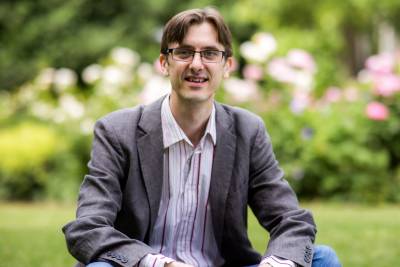Spirit of SLMS Winner (Scientific Excellence & Leadership)
Nils is a Swedish student who completed his PhD in 2018 in the Quantitative Imaging and Nanobiophysics Group of the MRC-LMCB at UCL, under the supervision of Dr Ricardo Henriques and Dr Alan Lowe. He is currently working a postdoctoral researcher in Ludwig Maximilian University of Munich, Germany.
Tell us a bit about your research achievements.
My PhD was was an interdisciplinary project on the advancement of “super-resolution microscopy” with a focus on providing the experimental and analytical methods to image single living cells both faster and at higher resolution than previously possible. The research performed during my PhD has had an immediate impact in the academic community facilitated by its presentation at both multiple international conferences and academic publications in the Journal of Microscopy and Nature Communications.
My most significant achievement was the publication of “Super-Resolution Radial Fluctuations” (SRRF), a novel image processing algorithm that forms the basis of a new approach to live-cell super-resolution. As it stands, the publication of SRRF has resulted in over 50 citations in both reviews and original research articles which have utilised SRRF to make novel biological discoveries. Following establishment of a research and development partnership with Andor, SRRF has now been successfully integrated into commercial cameras and sold as an instant-shot super-resolution method, SRRF-Stream. SRRF remains open-source and free as a post processing technique, as a part of the NanoJ software library and has been used over a million times in more than 50 countries.
NanoJ, which was developed originally to enable SRRF, has become a platform on which multiple algorithms have been developed for super-resolution related problems, including the published algorithms, NanoJ-VirusMapper and NanoJ-SQUIRREL. Following the publication of NanoJ, it is hoped that other developers will be able to make use of it to create efficient, GPU enabled algorithms as plugins for the commonly used ImageJ/FIJI software. The potential future impact of novel fluorescent probes developed during my PhD includes similar outcomes to those already being demonstrated by SRRF, i.e. the increased application of super-resolution to live-cell imaging and the increased application of super-resolution by researchers without access to specialised optical set-ups or expensive commercial super-resolution microscopes.
The increased accessibility to super-resolution methods that is granted by the research presented in my PhD is the primary source of its impact.
What have been some of the great milestones and/or achievements for you during your time at UCL?
The biggest milestone of my PhD include the academic publication in Nature Communications of SRRF and its subsequent integration into commercial cameras. Other notable milestones include the honour of presenting my research at the European Molecular Biology Laboratory (EMBL Heidelberg) “Seeing is Believing” conference in October 2015 where the 2014 Nobel Prize winners also spoke.
What role do you think public engagement of science plays in wider society?
The relevance of science to the modern world confers an obligation on us as scientists to develop more different and closer links with the public than scientists have had in the past.
That convergence will help develop the contract between scientists and society and help to move beyond what has often been seen as a paternalistic stance. This requires respect of and a response to the public's concerns - even when not fully shared by scientists - and engagement with the public in an open and honest dialogue about scientific research - including not only its benefits but also its limits, costs, and pitfalls.
In doing so, it will be important going forward to instil in the public consciousness the virtue of basic research which the academic sphere is ideally placed to conduct, in contrast to translational research being immediately and transparently valuable.
There are many opportunities for UCL students to engage in public outreach and I particularly enjoyed presenting image processing lectures to the public over the course of three days at the Royal Microscopy Society learning zone at the Microscience Microscopy Congress 2017.
Top 3 places/things to do in London?
With so many things to do in London it’s difficult to pick only three. If pushed I would choose:
- The Hunterian Museum - is a fascinating insight into early developments in medicine and surgery. Second,
- Walking in one of the many parks, my pick being Richmond Park or Hampstead Heath - the journey out of the centre to either of these is worth it.
- Exploring some of the over 4000 pubs in London, particularly some of those with historic origins and architecture or some of those that specialise in serving a massive range of independently brewed ales.
What would surprise people about you?
My first language was Swedish but my accent is now so British that even native Swedish speakers will reply to me in English.
 Close
Close


